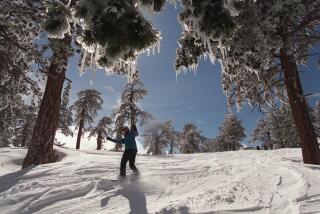Springtime served warm, with relish
- Share via
New Yorkers have a unique way of folding their newspapers to take up less room on subways and buses. They also possess the innate ability to walk, talk and eat pizza while crossing a street. And real New Yorkers are far friendlier than anyone would ever expect.
But there is nothing quite like the way New Yorkers experience spring, particularly one as desperately needed as this one.
With their parked cars lost in snowbanks for weeks on end and their skin chapped by an unrelenting cold, why wouldn’t New Yorkers think this winter had wrapped its icy fingers around each and every one of them in a very personal act of persecution? And to make matters worse, the city that already had its heart torn out by terrorism spent much of the winter, with the rest of the nation, ramping up to war.
So the sudden explosion of spring weather last week brought out people, not to mention birds in Central Park, and the Sabrett hot dog wagons on every corner. People poured into the parks, revealed white ankles below capris, and tentatively turned their faces toward the afternoon sun. And then one day, the temperature climbed almost to 70 and the hot-pink bags started arriving at Hallak Cleaners on Manhattan’s East Side, stuffed to the brim with winter coats.
Customers had peeled their North Face jackets and furs out of the front hall closet and shipped them off. The purpose of this exercise was not only to get the coats clean, but also to leave them there until fall, thereby freeing up premium closet space for spring wardrobes.
James Carvajal, manager of Hallak’s New York store, reports that while his highbrow customers are just beginning to spend weekends in the Hamptons or at Connecticut country houses, their wool clothes have taken up residence in New Jersey, where half of the dry cleaner’s Hackensack warehouse is temperature controlled and devoted to thousands of pairs of wool pants, business suits, cashmere sweaters and flannel jackets. “People leave 150 or 200 pieces with us for the winter,” Carvajal said. “There’s nothing more liberating than emptying your closet at the first sign of spring.”
The overstuffed pink bags pouring into Hallak are as much a harbinger of spring as the confused crocuses that poke through frozen earth in New England, and the cherry blossoms that never seem to arrive in time for Washington’s annual Cherry Blossom Festival -- all signs of a season that regularly snubs the calendar and comes when it’s good and ready.
New York is blessed with long, soft springs punctuated by occasionally wild swings of temperature and mood.
And so last week, the “Rat Rock,” a huge boulder on the northern tip of Central Park, was covered in talcum-powder handprints from the climbers limbering up for spring excursions to the mountains.
Young boys across the city insisted on wearing shorts to school all week, even when the morning temperature dove back into the 30s and some seasonally impaired adults at home forced them into fleece jackets and hats. The result: an ensemble that lectured winter from the waist up but screamed spring from the knees down.
There is perhaps no more welcome sign of a New York spring than the Sabrett hot dog wagons that appear out of nowhere on the first warm days. There is nothing like the sublime pleasure of standing under their yellow and blue umbrellas and ordering a dog ($1.50) with ketchup, mustard, sauerkraut and onions, then devouring it while walking an east/west block. It is important to choose an east/west block since these are longer than north/south blocks, allowing plenty of time to finish one dog before ordering another at the Sabrett wagon on the next corner.
According to local custom, it is then necessary to turn up a north/south block, say, Fifth Avenue, in time to hit a third wagon for a Yoo-hoo to wash it all down.
New York City Parks Commissioner Adrian Benepe rarely marks spring with such a gastrointestinal indulgence. Rather, he experiences the season through its auditory clues, particularly outside his office, which overlooks the sea lions in the Central Park Zoo. The zoo was a ghost town all winter but about two weeks ago chirping birds and shrieking children announced the new season beneath Benepe’s window.
Benepe actually has the best job in New York City -- if you don’t count playing centerfield for the Yankees or writing front-page headlines for the New York Post. A park ranger who worked his way up, now he manages the city’s 28,312 acres of parkland. The transition from winter to spring is usually a long time of betwixt and between -- tulips have been known to bloom in Central Park even as rangers clean up after a freak April snow.
But now more than ever, Benepe feels the importance of his duties. New Yorkers facing an “orange” alert and the green glow of a TV war, he says, need their open spaces. “We’re making the parks as clean and as nice and as welcoming as possible so when people start feeling depressed about things, they can come out into their shared backyards and be together.”
At least 10,000 New Yorkers -- mostly frustrated suburbanites -- will turn out to clean up the communal backyards, to do the planting and pruning and fencing that goes on in parks all spring and summer. Last week, at the department, the volunteer gardeners were already registering by the thousands for the privilege of dirtying their hands.
This season of unpredictability -- in the 70s one day, snowy the next -- is a good match for the conflicted mood of most New Yorkers these days. Nice weather delights us, but a brilliant blue sky will forever remind us of one awful Tuesday in September. Now we are poised to expect the most hideous, unimaginable events on the most unimaginably perfect day.
So we look for instruction on how to press on. Marechal Brown, gardener of the 30 acres of Morningside Park between Columbia University and Harlem, offers an inspirational story about one group of New Yorkers, indeed, classic survivors: About this time a year ago, Brown says, a mother duck decided she and her ducklings had had enough of the pond in Morningside Park. They were being harassed by people and other animals in what used to be called Muggerside Park, now much safer and cleaner since it got its own gardener. Still, the mother duck was not happy. So, just like the mom in the children’s classic “Make Way for Ducklings,” she escorted her six young ones almost a mile on city streets to Central Park.
Brown frantically followed the waddling troop, stopping traffic along the way to ensure they weren’t run over. Finally, they arrived at the Harlem Meer, a big slimy, grassy body of water adjacent to 110th Street. They were immediately confronted by two hostile ducks protecting their territory, a small island in the middle. That mother duck stood her ground, ignored the bullies, persevered through the pond scum and marched her little crew onto the aptly named Duck Island. A year later, they are still there.
More to Read
Sign up for Essential California
The most important California stories and recommendations in your inbox every morning.
You may occasionally receive promotional content from the Los Angeles Times.













